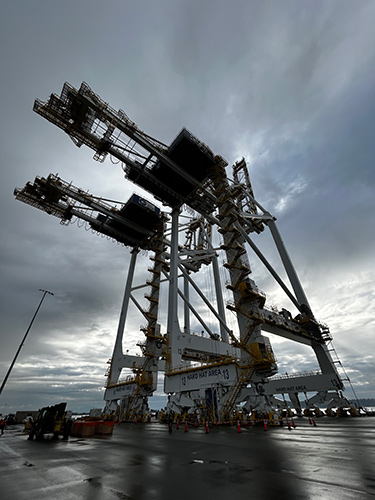Casper Phillips & Associates has witnessed commissioning of the first two Shanghai Zhenhua Heavy Industries ship-to-shore container cranes.

Casper, Phillips & Associates Inc. (CP&A) has witnessed commissioning of the first two Shanghai Zhenhua Heavy Industries Co., Ltd. (ZPMC) ship-to-shore container cranes — part of an order for six — at GCT Deltaport, Canada.
CP&A offers a wide variety of services, including specification, design, manufacturing review, modification, and accident investigation. Its initial role in this contract was advising on the largest conceivable cranes that could be installed on the dock, to serve the biggest possible container ships. The six sister cranes will all be built to the same set of drawings:
GCT’s Deltaport is Canada’s flagship container terminal. The 210-acre state-of-the-art site is in the outer harbor at Roberts Bank (Delta, B.C.), supported by a 3,609-ft. contiguous berth, and a dock rail with 27,350 ft. of tracks. Over 18,000 containers are typically stacked at any given time.
Having studied the wharf and determined the largest crane size that could feasibly operate, CP&A and GCT collaboratively developed modifications to a purchase specification from a previous project. CP&A performed a structural and mechanical design review of ZPMC’s design for compliance with the specifications. GCT employs many skilled electrical engineers who thusly took care of the electrical and control aspects.
The new, replacement ship-to-shore container cranes are remote operation ready; once the control infrastructure is equipped, they can be operated remotely. They are fitted with a ship profiling system, which helps prevent a collision between the lift system and containers on the vessel. Additionally, there is a chassis alignment programme that will scan and recognise the position of trailers; this aids the truck drive to help get properly positioned.
Richard Phillips, mechanical engineer at CP&A, said: “Once the design complied with the specifications, construction began, where we managed the on-site fabrication inspections. When the cranes arrived, we witnessed the final commissioning [acceptance testing] and the cranes are now ready to be put into operation. Acceptance testing is required by federal regulations to ensure the equipment is working correctly. These tests include everything from load testing to checking that every e-stop button works.”
He added: “GCT has been a repeat client for over a decade; we are constantly in contact with them, which makes working on long-term, multi-crane contracts like this much easier.”
Demolition of the original, smaller cranes on the wharf continues; the first two new cranes could be lifting before the end of the month (September).
CP&A also recently played a central role in creating a Site Wind Analysis and Monitor (SWAM) program, based on anemometers and weather forecasting technology, for GCT.
In this episode, I sat down with Beejan Giga, Director | Partner and Caleb Emerson, Senior Results Manager at Carpedia International. We discussed the insights behind their recent Industry Today article, “Thinking Three Moves Ahead” and together we explored how manufacturers can plan more strategically, align with their suppliers, and build the operational discipline needed to support intentional, sustainable growth. It was a conversation packed with practical perspectives on navigating a fast-changing industry landscape.